The Nobel Banquets – a century of culinary history
by Ulrica Söderlind*
Introduction

The first Nobel Prize Award Ceremony was held on the 10th of December 1901, capped with a banquet at the Grand Hôtel in Stockholm. Through the years, the Nobel Banquet has become an affair followed with great interest not only by those who are lucky to be invited, but even by those who content themselves with watching the event live from their television sets at home, reading about it in the newspapers the following days, or finding all about it at this web site, nobelprize.org.
Guests
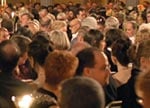
The first banquet in 1901 was attended by 113 male guests. In 1934, as the prestige of the Nobel Prize increased, more people became interested in attending the Nobel Prize Award Ceremony and the Nobel Banquet. The number of guests increased from 150 to 350. Today, some 1,300 guests are invited, among them members of the academe, government, cultural and industry sectors, diplomatic corps, and the Royal Family of Sweden.
Venues
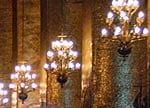 The Hall of Mirrors of the Grand Hôtel in Stockholm served as the venue for the first 29 years of the banquet, after that it was transferred to the Stockholm City Hall’s “Gyllene Salen” or Golden Hall to accommodate more guests. The Grand Hôtel hosted the Nobel Banquet again during the years 1931-1933. In 1934, it was moved back to the Golden Hall of Stockholm City Hall. During the Hungarian uprising of 1956, the Nobel Banquet was replaced by a simpler meal at the Swedish Academy. In 1974, it was held at the Blue Hall at the Stockholm City Hall which continues to be the venue to this day.
The Hall of Mirrors of the Grand Hôtel in Stockholm served as the venue for the first 29 years of the banquet, after that it was transferred to the Stockholm City Hall’s “Gyllene Salen” or Golden Hall to accommodate more guests. The Grand Hôtel hosted the Nobel Banquet again during the years 1931-1933. In 1934, it was moved back to the Golden Hall of Stockholm City Hall. During the Hungarian uprising of 1956, the Nobel Banquet was replaced by a simpler meal at the Swedish Academy. In 1974, it was held at the Blue Hall at the Stockholm City Hall which continues to be the venue to this day.
Logistics

Holding a gathering of this proportion and prestige entails a lot of preparation and hard work. Everything has to be synchronized to perfection. Being part of the staff is an exacting task and yet many covet to be part of the group that today includes a catering manager, banqueting hall manager, head chef, 8 head waiters, 210 waiters and waitresses, 5 wine waiters, 20 cooks and about 20 people responsible for washing up and transporting food. The shopping list for 1,300 covers is impressive. At one time it included 2,692 pigeon breasts, 475 lobster tails, 100 kilos of potatoes, 70 liters of sweet and sour raspberry vinegar sauce, 67 kilos of Jerusalem artichokes, 53 kilos of Philadelphia cheese, 45 kilos of lightly smoked salmon, the list can be made longer. Three days before the big day, preparations begin in the kitchen and everyone works according to a strict schedule.
Nobel dinner service
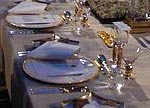 During the first years, guests were seated at tables arranged in the shape of a horseshoe. Today, long tables are required, with the table of honor set in the middle of the banquet hall. On the day of the Nobel Banquet the Blue Hall is laid out with 65 tables in exact positions using 470 meters of tablecloth. 30 people wearing white gloves begin the time-consuming task of laying out 6,730 pieces of porcelain, 5,384 glasses and 9,422 pieces of cutlery. The same care is given to each place setting, whether it is for the table of honor or the tables for students. In 1991, the Nobel Foundation ordered a specially designed dinner set in time for the 90th anniversary celebration of the Nobel Prize. The dinner service reflects Swedish design and culture and has become a total success.
During the first years, guests were seated at tables arranged in the shape of a horseshoe. Today, long tables are required, with the table of honor set in the middle of the banquet hall. On the day of the Nobel Banquet the Blue Hall is laid out with 65 tables in exact positions using 470 meters of tablecloth. 30 people wearing white gloves begin the time-consuming task of laying out 6,730 pieces of porcelain, 5,384 glasses and 9,422 pieces of cutlery. The same care is given to each place setting, whether it is for the table of honor or the tables for students. In 1991, the Nobel Foundation ordered a specially designed dinner set in time for the 90th anniversary celebration of the Nobel Prize. The dinner service reflects Swedish design and culture and has become a total success.
Theme
 Every Nobel Banquet has a particular theme. This is reflected in the decorations and the entertainment for the evening. Lilies, orchids, gladioli and roses in striking colors are used to enhance the theme for the evening. These flowers come all the way from San Remo, a center for flower cultivation on the Italian Riviera where Alfred Nobel spent the last years of his life. As a tribute to his memory the Azienda di Promozione Turistica di San Remo donate the flowers that are made into tasteful arrangements by professional florists. Every year, more than 23,000 flowers are used as decorations in connection with the Nobel festivities.
Every Nobel Banquet has a particular theme. This is reflected in the decorations and the entertainment for the evening. Lilies, orchids, gladioli and roses in striking colors are used to enhance the theme for the evening. These flowers come all the way from San Remo, a center for flower cultivation on the Italian Riviera where Alfred Nobel spent the last years of his life. As a tribute to his memory the Azienda di Promozione Turistica di San Remo donate the flowers that are made into tasteful arrangements by professional florists. Every year, more than 23,000 flowers are used as decorations in connection with the Nobel festivities.
The menus
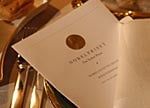
The menus are undoubtedly the highlight of the Nobel Banquet. In September each year, three menus suggested by selected chefs with impeccable international credentials are presented to the Nobel Foundation for tasting and testing. The selected menu is then kept secret until the actual day of the Nobel Banquet. The menus provide an interesting culinary history during the past 100 years. Below is a presentation of the general trends during each 10-year period, with one or two years randomly selected as examples.
1901-1910

During the first ten years, the menu started off with hors d’oeuvres. Translated from French to English, hors d’oeuvres mean “outside the work.” Today, the expression refers to the cold or hot appetizers or snacks preceding a meal, such as dark or white bread topped by white or red meat and different kinds of cheeses. They can also come in the form of pastry puffs filled with meat, fish, seafood, cheese and vegetables. This was followed by consommé, a clear soup made from seasoned stock. The main course consisted of red or white meat dishes. Dessert consisted of ice cream followed by fresh fruits and pastries. Dry champagne was served at the beginning and end of the meal.
The menu for the first Nobel Banquet was a five-course meal that cost 15 Swedish kronor (approximately 200 US dollars today). For this sum, the guests were served hors d’oeuvres followed by poached fillet of brill with white wine sauce. Brill is a flat fish found in Europe and is usually served for fine dining. This was followed by fillet of beef imperial, and breast of hazel grouse with Madeira sauce. Dessert consisted of Nobel ice cream parfait and fruit tartlette.
Chicken consommé with veal quenelles, fillet of sole with lobster sauce, salted saddle of lamb with Madeira sauce, cold fried hazel grouse with goose liver, green asparagus with virgin vinaigrette and ice cream à la Nabob were served for the banquet in 1910.
1911-1920
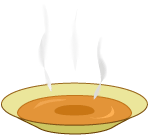
Hors d’oeuvres were no longer served during this period. Instead, consommés, of which turtle soup was the most popular, were served as starters. The main course consisted also of two kinds: meat and fowl or fish. The meal ended with ice cream, fresh fruit and pastries. During the years 1914-1919 no Nobel Banquets were held due to the war. The amounts intended for the Nobel Banquets were instead donated to the Red Cross.
The menu for 1920 started with consommé with fresh vegetables, followed by cold salmon with grilled tomato and haricots verts, and then came saddle of roe deer with artichokes and cauliflower, asparagus and was finished off with apricot ice cream parfait.
1921-1930

After World War I, the menus were slightly scaled down to four dishes. Turtle soup continued to be served as a starter. The reason for its popularity was probably the difficulty of finding turtles, making them expensive and exclusive. Turtle soup was usually prepared in this way: the meat is first slowly cooked in boiling water to form a bouillon. The resulting liquid is made into a soup with a dash of Madeira wine, herbs and lastly, the blood of the turtle is mixed into the liquid. The main course consisted of recipes made of duck meat, turkey, hazel hen or black grouse. The meal ended with different kinds of ice cream or parfait, followed by fruits or chocolates. Madeira was the drink during these years.
Veal consommé with cheese pastry started the menu for the year 1927. This was followed by fillet of turbot with oysters. Turbot is also a flat fish popular in European cuisine. Duck à la orange with artichokes came after the fish dish and the meal was rounded off with ice cream parfait with petis fours.
1931-1940

Meat from fowl was a favorite during this period. Duck, chicken, pheasant, and hazel hen figured very often. Turtle soup continued to appear as starters. Tomatoes, chestnuts and artichokes were served as side dishes along with risoto, an Italian rice dish, or mashed potatoes. Parfaits were served for dessert followed by fruits of the season and small cookies. Sherry was the most common drink during this period.
Due to World War II no banquets were held during the years 1939-1944. The amounts intended for the banquets were instead donated to the Red Cross.
In 1938, the meal was started with a consommé made of ox tongue and truffles. A delicate dish consisting of chilled fillets of sole with caviar sauce followed. Fried breast of chicken with artichokes and a side dish of salads came next. Dessert was ice cream soufflé with mixed fruit.
1941-50

After World War II, the dishes on the menu were reduced to three. Sandwiches were served for the first time. Different kinds of consommés and thick soups were served as starters followed by the main course, which was more varied during this period. Meat dishes consisted of reindeer, beef, goose or chicken. Fruits like apples and pears as well as cake were served after dessert, which usually consisted of ice cream.
The Scandinavian influence was very evident in the menu for 1946 which consisted of consommé with shellfish, roasted fillet of reindeer with lingon berry sauce. Lingon is a kind of red berry that grows wild in the forests of Sweden. Dessert was poached pear with ice cream.
1951-1960
 A big change from the first fifty years was that fish and shellfish were served as starters, such as salmon and lobster. The main course consisted of white or red meat from deer, beef, veal, lamb, cock, turkey, duck, chicken, and pheasant. Different kinds of fruits were served for dessert, often with a dash of cognac. Liqueurs such as cointrue, apricot brandy and cognac were served for the first time.
A big change from the first fifty years was that fish and shellfish were served as starters, such as salmon and lobster. The main course consisted of white or red meat from deer, beef, veal, lamb, cock, turkey, duck, chicken, and pheasant. Different kinds of fruits were served for dessert, often with a dash of cognac. Liqueurs such as cointrue, apricot brandy and cognac were served for the first time.
Lobster with asparagus, truffles and béarnaise sauce, saddle of roe deer with chestnut pureé and fruit savarin with marachino made up the menu for 1953. In 1957, salmon trout was served with herb sauce. Fried pheasant with port wine sauce and a side dish of vegetable salad came after. This was finished off with marinated pears with frozen cream.
1961-1970
 The menus for this period were similar to the previous ones. The practice of serving fish for starters continued as well as the use of red meat and fowl for the main course. Quite often fowl was served cold in different seasoned jellies. Black grouse, duck, hazel hen and capercaille meat were used. Fowl meat like chicken and partridge were served as warm dishes.
The menus for this period were similar to the previous ones. The practice of serving fish for starters continued as well as the use of red meat and fowl for the main course. Quite often fowl was served cold in different seasoned jellies. Black grouse, duck, hazel hen and capercaille meat were used. Fowl meat like chicken and partridge were served as warm dishes.
Smoked salmon with artichoke hearts, braised spinach and sauce mousseline started the menu for 1970. This was followed by stuffed fillet of reindeer with genever sauce. Dessert consisted of cloudberry savarin with mocca cream.
1971-1980
 The pattern of having fish for starters followed by fowl or read meat continued in this period. Dessert consisted of different kinds of ice cream and parfait. The now famous Nobel parfait was first served in 1976. It consists of an inner and outer parfait of different flavors and is usually served with a touch of drama. The “ice cream parade” as it is now known starts off with the lights dimmed down and fiddlers playing Swedish folk music as waiters and waitresses parade down the stairway of the Blue Hall, each with a tray of the Nobel parfait. Indeed, it is quite a feat carrying a tray containing frozen sherbet in the form of a tower!
The pattern of having fish for starters followed by fowl or read meat continued in this period. Dessert consisted of different kinds of ice cream and parfait. The now famous Nobel parfait was first served in 1976. It consists of an inner and outer parfait of different flavors and is usually served with a touch of drama. The “ice cream parade” as it is now known starts off with the lights dimmed down and fiddlers playing Swedish folk music as waiters and waitresses parade down the stairway of the Blue Hall, each with a tray of the Nobel parfait. Indeed, it is quite a feat carrying a tray containing frozen sherbet in the form of a tower!
Smoked snow grouse with juniper berry and werved with rowanberry jelly was served as the main dish in 1977. Paté of salmon with herb sauce was served at the beginning of the meal. The dinner ended with Nobel ice cream parfait.
1981-1990
 Fish was often accompanied with fowl for this period. If a starter was made of fish the main course would be made of meat or fowl, or if the starter was made of fowl, the main course was fish. A very strong Scandinavian influence could be seen in the composition of the dishes during this period. Examples of the Scandinavian influence are the starters of salmon mousse with crayfish sauce, cured fillets of reindeer, juniper berry cured salmon and pâté of smoked eel and sole. Other examples for the main course are fillet of moose with morel sauce, Brussel sprouts and jelly, leek potatoes, red schar braised in cream and dill, stuffed fillets of deer, back of marinated moose, lingon berry sauce and julienne of root vegetables. The Nobel parfait was served as dessert in all the years under this period.
Fish was often accompanied with fowl for this period. If a starter was made of fish the main course would be made of meat or fowl, or if the starter was made of fowl, the main course was fish. A very strong Scandinavian influence could be seen in the composition of the dishes during this period. Examples of the Scandinavian influence are the starters of salmon mousse with crayfish sauce, cured fillets of reindeer, juniper berry cured salmon and pâté of smoked eel and sole. Other examples for the main course are fillet of moose with morel sauce, Brussel sprouts and jelly, leek potatoes, red schar braised in cream and dill, stuffed fillets of deer, back of marinated moose, lingon berry sauce and julienne of root vegetables. The Nobel parfait was served as dessert in all the years under this period.
The menu for 1981 had a strong Scandinavian motif: salmon mousse with crayfish sauce for starters, fillet of moose with morel sauce as main course with leek potatoes and Nobel ice cream parfait for dessert.
1991-2001
 During all the years after World War II the menus consisted of three dishes except for the year 1991, when it consisted of four due to the 90th anniversary of the Prize. The starters during this period were mainly made of fish and shellfish served with vegetables and the main course consisted of wild game, mushrooms and berries from the forests of Scandinavia.
During all the years after World War II the menus consisted of three dishes except for the year 1991, when it consisted of four due to the 90th anniversary of the Prize. The starters during this period were mainly made of fish and shellfish served with vegetables and the main course consisted of wild game, mushrooms and berries from the forests of Scandinavia.
Nettle soup with quail egg started the menu for the anniversary dinner in 1991 followed by tartar of marinated salmon with red pepper cream. For the main course, it was roast breast of duck with archipelago sauce. A special parfait was made for dessert, the Nobel Gala ice cream parfait.
* Ulrica Söderlind, PhD, Senior lecturer, Umeå University school of Restaurant and Culinary Arts, Umeå University, Sweden, e-mail: [email protected]. Author of the book The Nobel banquets – a century of culinary history (1901-2001) published by World Scientific Press (in Swedish: Nobels middagar – Banketter, festligheter och pristagare under 100 år, Carlsson Bokförlag).